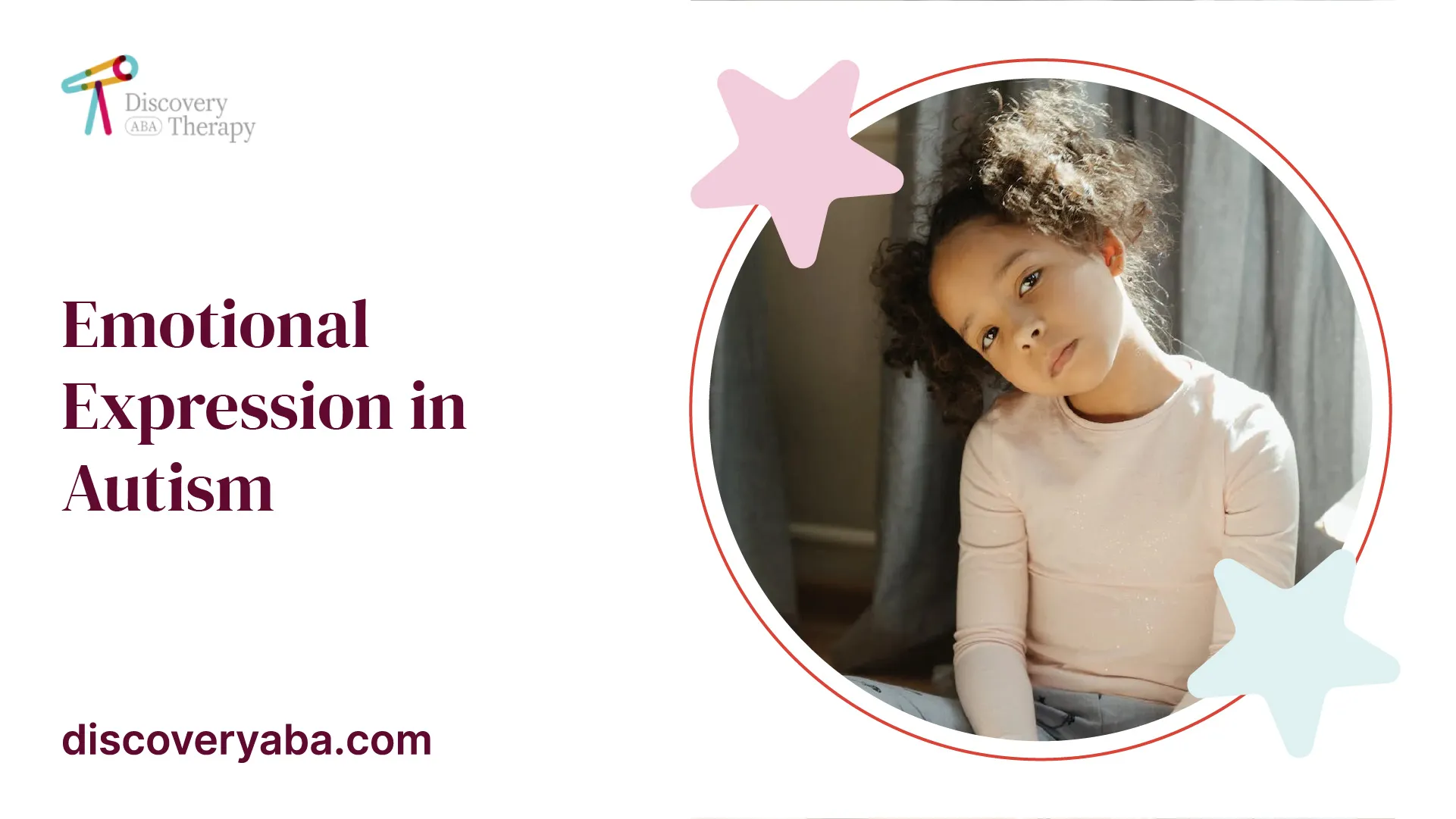Emotional Expression in Autism
In this article, we will explore what emotional expression in autism looks like, why it can be challenging, and how to foster healthy emotional development.
.jpeg)
Understanding Emotional Expression in Autism
Emotional expression plays a vital role in human communication and connection. For individuals with autism, the ability to express and understand emotions can be uniquely challenging. Understanding the importance of emotional expression, the specific challenges faced by individuals with autism, and the impact on emotional development is essential in providing support and fostering healthy emotional growth.
The Importance of Emotional Expression
Emotional expression is a fundamental aspect of human interaction and relationships. It allows individuals to convey their feelings, needs, and thoughts, forming a basis for empathy, understanding, and connection. Emotional expression helps individuals navigate social situations, build relationships, and regulate their own emotions.
Challenges in Emotional Expression for Individuals with Autism
Individuals with autism often face challenges in expressing their emotions in typical ways. These challenges may stem from difficulties in recognizing and interpreting emotions in themselves and others, as well as challenges in communicating and expressing their feelings verbally or nonverbally. Some common challenges in emotional expression for individuals with autism include:
- Difficulty identifying and labeling emotions
- Limited facial expressions and body language
- Challenges in understanding social cues and context
- Differences in processing and expressing emotions in a timely manner
The Impact on Emotional Development
The difficulties in emotional expression experienced by individuals with autism can have a significant impact on their emotional development. Difficulties in understanding and expressing emotions may contribute to feelings of frustration, isolation, or being misunderstood. The ability to form and maintain meaningful relationships may also be affected.
Understanding and addressing these challenges can help support emotional development and overall well-being in individuals with autism. By providing strategies, creating supportive environments, and seeking professional support, the emotional expression of individuals with autism can be enhanced, leading to improved emotional growth, resilience, and a better quality of life.

Building Emotional Connection
To enhance emotional expression in individuals with autism, it is crucial to focus on building emotional connection. By implementing strategies, creating a supportive environment, and promoting social interaction and communication, parents can help their children with autism develop and express their emotions effectively.
Strategies for Enhancing Emotional Expression
There are various strategies that can be employed to enhance emotional expression in individuals with autism. These strategies aim to create a safe and supportive space where emotions can be recognized, understood, and appropriately expressed.
Creating a Supportive Environment
Creating a supportive environment is essential for fostering emotional expression in individuals with autism. A supportive environment provides individuals with a sense of safety and acceptance, enabling them to express their emotions freely.
Promoting Social Interaction and Communication
Promoting social interaction and communication plays a vital role in enhancing emotional expression in individuals with autism. By creating opportunities for social engagement and providing the necessary tools and support, parents can help their children develop social and communication skills.
By implementing strategies for enhancing emotional expression, creating a supportive environment, and promoting social interaction and communication, parents can empower individuals with autism to express their emotions more effectively. These practices contribute to healthy emotional development and foster a stronger emotional connection between individuals with autism and their loved ones.
Supporting Emotional Expression at Home
When it comes to supporting emotional expression in individuals with autism, the home environment plays a crucial role. By creating a nurturing and understanding atmosphere, parents can help their child develop and express their emotions effectively.
In this section, we will explore three key strategies for supporting emotional expression at home: encouraging self-expression, using visual supports and tools, and incorporating sensory strategies.
Encouraging Self-Expression
Encouraging self-expression is vital for individuals with autism to develop a healthy emotional outlet. Parents can create a safe space where their child feels comfortable expressing their emotions without fear of judgment or criticism. Here are some ways to facilitate self-expression:
- Active listening: Take the time to actively listen to your child's thoughts and feelings. Show genuine interest and validate their emotions, even if they may seem different from your own.
- Use open-ended questions: Instead of asking yes-or-no questions, ask open-ended questions that encourage your child to express their thoughts and feelings in more detail.
- Provide outlets for creativity: Engage in activities that allow your child to express themselves creatively, such as art, music, or writing.
By fostering a supportive environment that values and encourages self-expression, parents can help their child navigate and communicate their emotions effectively.
Using Visual Supports and Tools
Visual supports and tools are effective aids in enhancing emotional expression for individuals with autism. Visual cues can help them understand and communicate their emotions more clearly. Here are some visual supports and tools that can be beneficial:
By incorporating visual supports and tools into daily routines and interactions, parents can provide their child with the necessary resources to express and understand emotions effectively.
Incorporating Sensory Strategies
For individuals with autism, sensory sensitivities can impact their emotional well-being. Incorporating sensory strategies at home can help create a calming and regulated environment. Here are some sensory strategies to consider:
- Sensory breaks: Designate a quiet and sensory-friendly space where your child can take breaks when feeling overwhelmed or overstimulated. This space should include sensory tools like stress balls, weighted blankets, or fidget toys.
- Sensory diet: Work with an occupational therapist to develop a sensory diet tailored to your child's needs. This may include activities that provide sensory input, such as swinging, deep pressure, or tactile play.
- Visual cues for sensory regulation: Use visual cues, such as color-coded timers or visual schedules, to help your child anticipate sensory experiences or transitions, reducing anxiety and promoting emotional regulation.
Incorporating sensory strategies into your child's daily routine can help them manage their emotions more effectively and create a more harmonious home environment.
By implementing these strategies, parents can support and empower their child with autism in expressing their emotions and fostering healthy emotional development. It's important to remember that every individual with autism is unique, so it may take time and patience to find the strategies that work best for your child.
Seeking Professional Support
When it comes to enhancing emotional expression in individuals with autism, seeking professional support can play a crucial role. Therapists, specialists, educators, and other professionals can provide valuable guidance and interventions to support emotional development.
In this section, we will explore the importance of working with therapists and specialists, different therapy approaches for emotional expression, and the benefits of collaborating with educators and professionals.
Working with Therapists and Specialists
Therapists and specialists who specialize in autism can provide targeted interventions and support for individuals with autism. They have the expertise to assess emotional expression difficulties and develop personalized strategies to enhance emotional skills. These professionals may include:
- Behavioral Therapists: Behavioral therapists use techniques such as Applied Behavior Analysis (ABA) to teach emotional regulation, social skills, and communication.
- Speech-Language Pathologists: Speech-language pathologists can help individuals with autism improve their verbal and nonverbal communication skills, which in turn can enhance emotional expression.
- Occupational Therapists: Occupational therapists focus on sensory integration, self-regulation, and fine motor skills, which can have a positive impact on emotional expression.
Collaborating with therapists and specialists can provide a comprehensive approach to addressing emotional expression challenges in individuals with autism.
Therapy Approaches for Emotional Expression
There are various therapy approaches that can be effective in enhancing emotional expression in individuals with autism. These approaches are tailored to the specific needs and abilities of the individual. Some commonly utilized therapy approaches include:
These therapy approaches can be used in combination or individually, depending on the unique needs of the individual with autism.
Collaborating with Educators and Professionals
Collaboration between parents, therapists, and educators is essential for supporting emotional expression in individuals with autism. Educators play a vital role in creating an inclusive and supportive environment in schools, where emotional expression can be nurtured and encouraged.
By sharing information, strategies, and goals, parents can work together with educators and professionals to ensure consistency and reinforce emotional development both at home and in educational settings.
Collaboration may involve:
- Individualized Education Plans (IEPs): Developing IEPs that address emotional expression goals and provide necessary accommodations and supports within the school environment.
- Regular Communication: Maintaining open lines of communication between parents, educators, and professionals to exchange feedback, discuss progress, and address concerns.
- Training and Workshops: Participating in workshops and trainings provided by educators and professionals to gain a better understanding of strategies that can be used to support emotional expression.
By collaborating with educators and professionals, parents can create a unified support system to promote emotional expression in individuals with autism, both in and out of the therapy setting.
Celebrating Progress and Individuality
Supporting emotional expression in individuals with autism is a journey that requires patience, understanding, and celebration of their progress and individuality. By embracing the unique emotional expression of individuals with autism, fostering emotional growth and resilience, and cultivating positive emotional well-being, we can create a nurturing environment that promotes healthy emotional development.
Embracing the Unique Emotional Expression of Individuals with Autism
Individuals with autism have their own distinct ways of expressing emotions. It is essential to recognize and appreciate their unique emotional expression, as it may differ from neurotypical individuals. By acknowledging and accepting their individuality, we can create an inclusive environment that allows for authentic emotional expression.
Fostering Emotional Growth and Resilience
Emotional growth and resilience are vital aspects of healthy emotional development in individuals with autism. It is important to provide opportunities for emotional exploration and growth, tailored to their specific needs and preferences. This can be achieved through various strategies such as:
- Encouraging self-awareness and self-regulation: Helping individuals with autism recognize and understand their emotions, and providing them with tools and techniques to manage their emotional experiences.
- Teaching coping skills: Equipping individuals with autism with effective coping strategies to navigate challenging emotional situations and build resilience.
- Promoting emotional intelligence: Supporting the development of emotional intelligence by helping individuals identify, understand, and empathize with the emotions of themselves and others.
Cultivating Positive Emotional Well-being
Creating an environment that cultivates positive emotional well-being is crucial for individuals with autism. This can be achieved through the following:
- Nurturing a supportive and accepting atmosphere: Fostering an environment where individuals with autism feel safe and supported to express their emotions without judgment or criticism.
- Encouraging meaningful connections and relationships: Facilitating opportunities for social interaction and fostering connections with peers, family, and friends, which can contribute to emotional well-being.
- Providing outlets for self-expression: Encouraging individuals with autism to engage in activities that allow them to express themselves creatively, such as art, music, or writing.
By celebrating the progress and individuality of individuals with autism, we can create an environment that promotes emotional growth, resilience, and positive emotional well-being. Remember, each individual has their own unique emotional journey, and by embracing their distinct expression, we can support their healthy emotional development.
Conclusion
Emotional expression in autism can be challenging, but it is possible to foster healthy emotional development. By understanding the unique challenges that people with autism face and providing support and encouragement, we can help them develop the skills they need to understand and express their emotions.
Sources
Does Your Child Have An Autism Diagnosis?
Learn More About How ABA Therapy Can Help
Find More Articles
Contact us
North Carolina, Nevada, Utah, Virginia
New Hampshire, Maine
Arizona, Colorado, Georgia, New Mexico, Oklahoma, Texas
.avif)




































































































